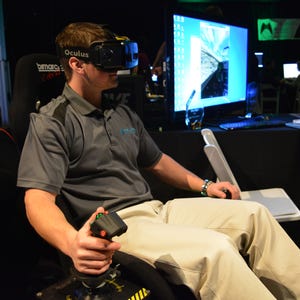For a while now,
Dark Souls has been the litmus test of “hardcore.” A bright line between the casual mongrels and the real gaming stewards of the universe, an image helped none by the “Prepare to Die” ad campaign that has lived well beyond its syndication and into the actual title of one of the games. And it’s not a dishonest statement. You will die in
Dark Souls. It is hard. But it isn’t impossible. Or, in my opinion, terribly difficult.
It’s a seemingly paradoxical standpoint if you consider “challenging” and “difficult” to be the same word. While I find
Souls games to be incredibly challenging, I don’t find them to be difficult. I find
Call of Duty to be difficult. Somewhere along my gaming lifetime, my ability to line up twitch reflex headshots waned as my strategy gaming micromanagement waxed. I’m not going to be one of those self-righteous assholes that thinks there’s something inherently superior about more “intellectual” games like
The Walking Dead,
Civilization, and
Fez. These are just games that I prefer.
Dark Souls has always met my sweet spot between the contemplative and the reactive. It requires a decent amount of spot reflexes to properly dodge/parry/block all of the attacks, but also requires you to learn the pattern. Not only must you master the wind-ups and follow-throughs of your foes furious flurries, but also your own. Run out of stamina, and you’re fucked. It’s certainly tough, but not the sisyphean torment that a lot of people pretend it is. I mean, I beat most of them drunk.
The reality of
Dark Souls has never been the myth of “ultra-brutal” that many perpetuate. For those on the periphery, the circulated meme will always be a picture of a broken controller and “WELCOME TO
DARK SOULS, GIT GUD LUL!” For fans, it’s all about praising the sun, uncovering all of the covenants, beating the Pursuer your first try, and finally backstabbing Havel enough times without getting your skull crushed in. It’s not a torture, but a rapturous journey, a series of joyous achievements whose peaks are unmatched in other titles.

I’ve had whole relationships less satisfying than beating this stupid asshole’s shiny metal face in.
It might seem like I’m exaggerating a bit, and perhaps I am. There’s really just nothing quite like it. That is, unless you are talking about
Dark Souls III. In which case, it’s basically just the first
Dark Souls. Even as an amalgamation of the various elements that made
Dark Souls,
Dark Souls 2,
Demon’s Souls, and
Bloodborne great, it’s still clearly more
Dark Souls than anything else. In a game where continuity is mysterious and plot is more of a backdrop than a driving force,
Dark Souls III is as direct a sequel to
Dark Souls as you can get.
This isn’t me heaping major shit on
Dark Souls III. There are much worse things than being basically just
Dark Souls. There’s an entire industry based on being basically just
Dark Souls, and I’m fine with that. At its core, it’s still the high stakes, fast and fluid combat that I love. It’s still the same vague, mysterious world that just begs to be picked apart. The foes are still menacing, options vast, arsenal unique, and deaths punishing. I still love this game. Just not as much as the rest.

Although, as you can tell from all my pictures, I love the shit out of the Fume Ultra Greatsword.
After an initial first area that surprisingly didn’t have a “must lose” battle, you warp into the walls of Lothric and immediately drink in a rich and heavy sight. Along with many a tidbit for lore-nerds to pour over their significance, an array of tortured and wailing undead flank you at either side. They aren’t all immediately aggressive, most simply cowering and praying in desperation to gods who have long since forgotten their prayers. You will slaughter them for their sweet, sweet souls.
After making your way through a handful of undead, you immediately face your first wyvern (think dragon). He’s not a boss, and functions as a living trap that must be figured out and avoided. This is not a daunting task. Even if you can’t figure out his simple, “spray fire, take a nap, repeat” pattern, he only does little piddles of damage that can easily be healed through. It’s clearly much of a less dick move than The Bridge Wyvern, but the parallel is clear. As a method for introducing the character to the concept of “expect anything at any time,” it’s more forgiving. It’s also way less memorable.

I wonder if I can resist the urge to pick up all the items sitting in his blast radius. *SPOILER ALERT* I couldn’t.
The wyvern isn’t the only parallel to the first
Dark Souls. There’s an undead town, a poison swamp, a skeleton catacomb, and you even return to Anor Londo. There’s a wooded area with an animal covenant, and even a couple secret zones. However, the actual design of said levels feels much more like a mix between
Dark Souls and the more linear
Dark Souls 2. Zones are sprawling and rife with interconnected paths and shortcuts, but the actual connection between the zones feels initially loose. It’s a lot of large elevators taking you to wildly different areas.
It’s a point that I feel will be contentious with fans. The environments are more varied, but it comes at the cost of world cohesion. When you take a step back and look at it as a whole, you can see the threads holding everything together. It wasn’t until my second playthrough that I realized the shattered bridge I had to teleport across earlier is actually a zone you travel to later. As a world, it is certainly tied together. It just pales in comparison to the interconnected world of the first
Dark Souls. There are instances of hidden keys leading to spiral staircases that lead back to an unopened door in a previous level, but the entire map of
Dark Souls was an interconnected system of veins and arteries crisscrossing through the world to make it a living, breathing organism.
Dark Souls III is a series of large, open, and interesting hubs.

The imagery depicts a massive scale without delivering. You’ll travel the walls of that castle in the distance, but only briefly.
Combat, on the other hand, is significantly improved. There might be some who will prefer the clunkier style of the older games, but
Dark Souls III is faster, fluid, and more responsive. Hitboxes are refined, with a layering that expands your stagger impact beyond your range of damage. Staggering large enemies can now be followed up with a powerful riposte, which previously was reserved for smaller humanoid enemies. All weapons now have a “Weapon Skill,” which ranges from a simple damage upgrade to a devastating power attack. Magic has been revamped, with spells no longer having set charges and instead utilizing a new “Focus Point” bar. Similar to health, FP does not regenerate over time, and must be recharged with “Ashen Estus Flasks.” Weapon Skills also require FP, but not to the degree that spells do. You set your number of Ashen flasks and regular Estus from the same pool, meaning that your Soul Arrow spamming comes at the cost of overall longevity. It’s a novel way to balance the system, as it was previously a huge advantage at very little cost to have just enough stats for some minor spells. It’ll take a legion of fans playing for months to figure out how the balancing worked exactly, but I found it made the PVP much more variable.

Which is perfect for me, who employs more of a “you’ll be in a world of hurt when I finally waddle over to get you!” tactic
It’s easy to see the patchwork frame that director Hidetaka Miyazaki assembled from his other games. The first
Dark Souls is the foundation, the skeleton and north star guiding the rest of the game’s design. The ember system and central isolated hub is a callback to
Demon’s Souls, and even has it’s own murdering traitor NPC. The more streamlined level design is a product of
Dark Souls 2, and the more fluid combat is inspired by Miyazaki’s similar franchise
Bloodborne.
That isn’t to say the world lacks its own identity. While
Dark Souls had a lonely, dead world feel,
Dark Souls III is rich with decay. It feels a bit more like
Bloodborne, full of body horror, wailing tortured souls, and otherworldly creatures just beyond your reach. Powering yourself up with an “Ember” is the replacement to restoring your “Humanity,” and causes your skin to crack and flake revealing a flame within. It’s a momentary, fickle spark of light in a world extinguished. In this descent into ashes, the world is more alive in its undeath, just like a long dead corpse now bloated with maggots wriggles and breaks down.

Yoel of Londor is a particularly pitiful character. Of all the NPCs struggling through, his gnarled hands and hunched back tell the greatest story of struggle.
I’ve been waffling back and forth between the good and the bad this whole review, which I can understand is a bit confusing. My feelings on the world are mixed, and the more time I spend analyzing the bits the more I grow to like them. It’s a game I like in a franchise I love, but it’s difficult to describe why exactly it let me down without pointing to something that another equally fervent fan might love. So I’m left with one, solid criticism. It never took me more than two tries to beat any boss in
Dark Souls III. For a game that I cherish for being a challenge, these landmark fights were alarmingly easy. Aside from the Nameless King and High Lord Wolnir, I struggle to remember a single fight. It’s the same formula of “kill four great lords to unlock the last boss,” but none of them are as menacing as the towering bundle of corpses that was Nito or the terrifying Four Kings. Nothing even comes close to the epic challenge of Ornstein and Smough. There’s actually a boss that is just a bunch of dudes. For a game that is otherwise fantastic, I was incredibly disappointed.
I have to remind you that I’m rating this on a scale of
Dark Souls. As a game, it’s still great, and one I’d almost universally recommend. The polished combat and smoother difficulty curve will bring in plenty of new fans, and I seriously doubt it will ostracize any old ones. I liked all the changes, and it’s clear that the future of the series is somewhere along these lines. I just can’t ignore that for a series that has sucked hundreds of hours out of me, the twenty hours that it took me to beat
Dark Souls III are almost all ephemeral. If I close my eyes, I can see the route through Undead Burg, into the Depths, down through Blighttown, and into the Quelaag fight on the inside of my eyelids. When I have to look up on the wiki to remember the bosses,
Dark Souls III has done something wrong. It’s a game you will play and likely love. Hopefully, it will inspire you to play the rest of the series. We can always use more sunbros praising
http://www.dreadcentral.com




























